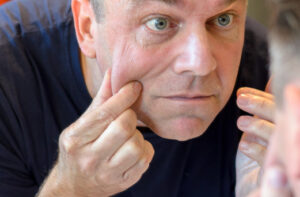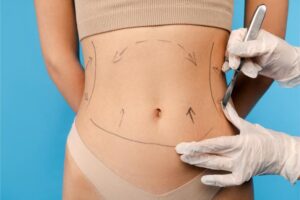
Are you considering breast enlargement surgery? Wondering what your recovery will be like? Read this comprehensive recovery guide, and contact us with your questions at phone 858-295-4001 or info@feelbeautiful.com.
ABOUT THE AUTHOR
Dr. Steve Laverson’s private San Diego Feel Beautiful Cosmetic Surgery Center is known for high quality proportionate natural breast augmentation and breast lift. His office is accredited by the American Association for Accreditation of Ambulatory Surgical Facilities. Dr. Laverson is a diplomate of the American Board of Plastic Surgery and an active member of the American Society of Plastic Surgeons and the American Society of Aesthetic Plastic Surgeons, and a Fellow of the American College of Surgeons. He has been in practice for 25 years.
Although every woman is unique and will not follow the same exact course, general principles apply. Recovery explained here assumes general anesthesia, a clean fully accredited surgery center, and standard of care features of the operation. These include mature surgical judgment, proper implant selection and placement, antibiotics, professional surgical technique with minimal bleeding, multiple layer durable wound closure, and a surgeon responsive to patient needs with respect to nausea prevention and analgesia (pain control).
Beyond the above expectations for your breast implant procedure, several features may intensify your experience. If you are hypersensitive to pain, explain this to your surgeon in advance. Additional or stronger medications should be prescribed. If you are diabetic, if you smoke tobacco, or if you have medical or mental health issues, these should also be disclosed to your surgeon. Management of your situation is incorporated into your care plan.
Breast augmentation involves placement of a sterile round or elliptical device into a surgically created space, or “pocket.” The pocket shape is round. The location and limits of the space may be marked on your skin before surgery to guide the surgeon during your procedure. The space is large enough for the implant, but not too large so implants don’t shift to an undesired location after surgery. The space is behind your skin and your breast gland, and the space is in front of your ribs and/or your chest wall muscles. Tissues surrounding the pocket (muscle, ribs, skin) are of limited elasticity. The larger the implant that is inserted into your pocket, the more tension there is on your wound closure, and the tighter your muscle and skin are after surgery. There is a relationship between skin and muscle tension and post- surgical pain. Pressure applied to the chest wall also causes pain, and a larger implant may apply increased pressure for a period of time. Your body responds to pressure created by a breast implant. Skin and muscle expand to accommodate the device, and as pressure drops, your pain diminishes. After weeks to months of slow tissue expansion, the implant settles and assumes a more natural appearance and shape. Pain completely resolves in most cases. Until resolution of your pain, analgesics (pain medicine) should be used to help you remain comfortable, and resume your daily activities. In all circumstances, follow specific instructions of your surgeon and direct questions to your surgeon.
Muscle is more stiff (less elastic) and offers more resistance to expansion than skin. Because breast skin elasticity is greater than muscle elasticity, an implant behind your pectoralis muscle, especially if it is a large implant, may be associated with more tension and related pain than implant placement in front of your muscle. Implant placement affects recovery to some degree, and may influence your long-term result as well. Advantages and disadvantages of pocket placement on the muscle surface vs. deep to the pectoralis chest muscle should be reviewed with your surgeon so the best pocket position for you can be selected.
If you have had children, nursed, or breasts have shrunk with weight loss, your breast skin is already expanded. Aging also loosens skin. If you’re among that population, tension upon the skin imposed by an implant is diminished for you, and recovery will likely be easier. There is greater tissue tension imparted to surrounding tissues for young women with tighter skin, especially if larger implants are desired.
Procedures performed at the same time as your augmentation, such as breast lift, tummy tuck, liposuction, nipple revisions, and/or other operations will affect your recovery. Additional demands for care of other procedures during healing and additional associated pain are common. If you have tuberous breasts, significant breast asymmetry, Poland’s syndrome, or other indications for additional breast reconstruction, recovery may be longer and/or more complicated.
If your life is more physically demanding than average by your career, by your fitness routine, by your child care, or in other ways, recovery to this high level of function may take longer. Your expectations before surgery also affect your recovery. If you expect it to be difficult and disabling, your experience is likely to be better than expected. If you expect to be working, caring for children, exercising, and socializing immediately after breast augmentation, you may be disappointed.
Post-surgical garments such as a supportive bra and/or breast strap may be supplied by your surgeon or prescribed to help position or stabilize implants, and to control swelling.
In any case, your return to normal activities should be two to six weeks. The final aesthetic result of your augmentation, including tissue expansion, settling, dissipation of visible scar, and return of nipple sensation usually progress over six to twelve months.
Dr. Steve Laverson advises his own patients what to expect based on individual lifestyle and aesthetic preferences. At Feel Beautiful Plastic Surgery, we listen to understand your needs and your vision. Your procedure is planned accordingly, for feminine sensuous allure, for safety, and for the easiest healing and recovery experience.
Breast augmentation recovery timeline, and what to expect from your body
Phase 1
The first few days following breast augmentation are characterized by fatigue, discomfort or frank pain, limited mobility, and swelling around your breasts. You may be nauseated from narcotic analgesics. Both pain and nausea must be controlled. Communicate with your surgeon if you’re suffering, vomiting, or otherwise not OK. Deep breathing is important, so use enough pain medication that you can breathe deeply several times per hour while awake. Most women experience some relief or compensatory euphoria when they look down and see how nice their new look is developing!
Phase 2
One week after your surgery, pain begins to dissipate, and mobility increases. You’ll likely feel well enough to return to work and/or child care responsibilities. No strenuous work or fitness until your surgeon sees you in follow up and confirms that your wound(s) are healing well. Recommendations with respect to support and/or post-surgical garments will be forthcoming.
Phase 3
After two weeks, your body will feel more ‘normal’. Non-strenuous daily activities will resume. Pain with movement will still be felt. Wounds are still not healed enough to resist stress, so heavy work and fitness don’t resume until your doctor advises it is safe.
Phase 4
About a month after your surgery, most women slowly return to exercise as able. At any time, if your condition worsens or you observe something unexpected, call to inform your surgeon. Dr. Laverson advises women “listen to your body.” If your body hurts when you do something, it’s telling you that you’re not ready for that yet. Back off, and allow further healing, but try again in a week or two.
Phase 5
Six weeks after breast augmentation, most women are able to engage in more strenuous work and fitness. Upper body training will still be uncomfortable, especially if your implants are sub-pectoral (“dual-plane,” or “sub-muscular”). Swelling and tightness are improving, and as implants slowly settle over weeks and subsequent months, your breasts appear more natural and feel like they’re a part of you. At this time, many women shop for new bras and/or swimwear. The problem many women experience at this stage is increased attention, some wanted, and some perhaps not wanted. Another consequence of augmentation for some women: unplanned pregnancy. Welcome to the new you!
Caution
While the above description is typical of most recoveries, there may be wide variation from the norm. Every woman is different, unique, and beautiful. If your experience happens to differ, that doesn’t necessarily indicate a problem. Communication with your surgeon at all times before and after your procedure is important. It’s your surgeon’s responsibility to support and care for you, and it’s your responsibility to follow instructions and to inform your doctor about your progress and problems. Dr. Laverson and the Feel Beautiful Plastic Surgery staff enjoy supporting women in the journey to confidence, to femininity, and to success!
Advice and tips for a successful recovery
- Immediately home after breast augmentation, rest, pain medicine as needed, deep breathe, drink fluids, eat as able, call doctor if nauseated or other medication side effect. Adjust bra as needed for comfort.
- Don’t wear anything too tight or anything which requires too much effort to put on.
- Plan enough time off work, and get reliable help with child care if necessary.
- Avoid sleeping on your stomach (prone). Sleep on your back or sides. If it helps, stack cushions behind you so it’s easier to get out of bed.
- Use elbows, hips, knees, and back for mobility. Shoulder movement may hurt. Use restroom liberally, and laxative if you’re constipated from pain medicine. Fiber in diet helps counteract constipation. Magnesium containing antacids may also help. Call your doctor if you’re uncomfortable and not having bowel movements.
- Get lots of rest and sleep. Diet is unrestricted, whatever you want, healthy is best.
- No jogging, running, jumping, or other movement which causes your breasts to bounce or shake, until healing is complete.
- Ice cream, chocolate, and other treats acceptable, helpful, and you deserve it!
- A caring responsible adult must be with you the night after surgery. Such help is valuable for several days after breast augmentation.
CALL US FOR MORE INFORMATION ON BREAST ENHANCEMENT, BREAST AUGMENTATION, BREAST LIFT, OR BREAST AUGMENTATION-LIFT, 858-295-4001 OR INFO@FEELBEAUTIFUL.COM.
Feel Beautiful Plastic Surgery
11199 Sorrento Valley Rd STE 202, San Diego, CA 92121
858-295-4001
https://feelbeautiful.com/

 Book Now
Book Now











